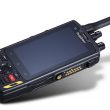HP gets the word out
Industry giant Hewlett-Packard recently launched a new version of its iPAQ smartphone, giving enterprises another tool for their mobile work forces.
The smartphone market will reach an expected 120 million units in 2007, according to Gartner Research. This may be why HP is boosting its efforts to capture some attention with the launch of the iPAQ 510 Voice Messenger in the U.S., which will hit the market this spring at a cost of $299 to $349.
It is a dual-mode device that moves from GSM, GPRS or EDGE cellular networks into 802.11b/g networks, said Niraj Gandhi, the product’s marketing manager. It is a voice- rather than data-centric smart phone that offers Windows Mobile 6, an operating system that combines a suite of basic applications for mobile devices. It also has a 12-key, instead of a QWERTY, keyboard — as seen on some other smart phones — and offers built-in Wi-Fi, GSM/EDGE and Bluetooth wireless technologies, Gandhi said.
The device uses Bluetooth to support its voice-command application for hands-free operation, dubbed VoiceReply. A Bluetooth headset is used in the application. By tapping the headset, users can use voice commands to instruct the device to read e-mail or calendar data. It also converts text e-mail to voice via a .wav file conversion.
The device also has fully integrated Wi-Fi 802.11b/g for voice-over-IP (VoIP) calls. If a business or corporation uses VoIP private brand exchange, or IPPBX, network software in the office, an employee using the iPAQ can turn on Wi-Fi and get onto the corporate network. Once they connect, the smartphone essentially replaces their IP desk phone, Gandhi said.
“So even while you are mobile in the office, you can still receive your office calls anywhere you are in the company, including those companies with multiple campuses,” Gandhi said. “In fact, if you are traveling internationally and you get into a hotel with Wi-Fi, then you can tunnel into the VPN and then into the corporate network and get into the IPPBX.”
The iPAQ 510 has an extended battery life of 6.5 hours of continuous talk time, which is supported by a lithium-ion battery and proprietary internal components for software optimizations, Gandhi said. One example he offered was the device’s ability to run applications using less power by reducing the time the light-emitting diode, or LED, screen is kept on when the phone is not in use.
“When we started this project, we went out and talked to a lot of enterprises and small to mid-sized companies,” he said. “And one of the key requirements was a battery with enough juice that employees wouldn’t be running around in the middle of the day trying to look for an electrical socket so they could charge their device.”
However, critics argue the new technology may not give HP the boost it seeks. The company’s iPAQ shipments fell from 2.66 million units in 2004 to 1.72 million units in 2006, despite the fact the personal digital assistant market grew by more than 40% in the same period, according to Gartner. The firm believes HP’s iPAQ smartphone will not meet the expectations of its customers and is unlikely to gain much traction in either the consumer or enterprise market, said Ken Dulaney, Gartner market analyst.
“HP has entered the highly competitive smartphone market with the iPAQ 500 series Voice Messenger,” Dulaney said. “But it’s not clear whether its features will appeal to enterprise users.”












